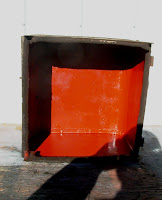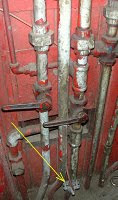First of all, we'd like to thank everyone who helped out with the World's Greatest Hobby show last weekend. Ray Bellock and Sam Polonetzky worked all day Sunday, and I already mentioned the people who worked on Saturday. Ed Rosengren is in charge of the other train shows we have a presence at, and all the members who help him deserve credit too.
So first, I dropped off the various items we used for the display.
And I continued working on replacing the control jumper receptacles and their wiring on the 36. The receptacles are on hand, along with nearly all the parts, and I should be able to start soldering them up at home soon. Rod acquired some armored cable, but I had given him some misleading information, and we'll need a different size. After some more measurements, we're probably on the right track.

Let's look at the junction boxes under the floor. (These pictures are looking straight up.) Here we have the box at the #1 end. There are ten terminals, for the nine wires in the control jumpers and the power supply for the controller. From the left, the cable from the controller enters the box. On the right, the upper cable goes to the #2 end, and the lower cable goes to the control group. There should also be two cables going to the left to the two receptacles at this end, but all of that was removed at Cleveland. Evidently they thought the wiring was bad.

The #2 end is similar, except that there's no cable to the control group, and therefore the power supply line is a separate red wire, which goes across the top. The cable to the #1 end goes to the left, and the cable to the controller goes to the right. At this end the cables to the receptacles were just hacked off, so I decided I might as well remove the remains now. The bolts were frozen, so it took a while.

After the excess wire is removed it's much neater. You get a better idea of just how it's connected. The various wires are color-coded as specified by GE.
I also spent a couple of hours stripping paint, as usual.

For a break, let's look at the ventilators. All other preserved wooden cars have "Utility" ventilators, so the 36 is an oddball. The ventilators have some louvers, covered by hinged metal plates sort of like chutes, as perhaps you can see here. There must have been some sort of little hook or casting at the top so the doors could be opened easily, but they have all disappeared. They can be pried open with some difficulty.

When closed, they look like this:
At some point I'll have to work on these. For normal operation, they can just be left open.
 Electrical repairs on car 36 are still the main priority right now, so I brought out the first MU socket kit to install. Because this one has a very short run of armored cable, I needed some brief help from Dan Fenlaciki to get the parts to line up, but here it is attached to the car.
Electrical repairs on car 36 are still the main priority right now, so I brought out the first MU socket kit to install. Because this one has a very short run of armored cable, I needed some brief help from Dan Fenlaciki to get the parts to line up, but here it is attached to the car.
 When Frank arrived, he helped me sequence the system and check all the connections. Here we have a light box which can be connected across various combinations of terminals in the jumper to verify that everything was wired properly and insulated. So that's one down, and three to go!
When Frank arrived, he helped me sequence the system and check all the connections. Here we have a light box which can be connected across various combinations of terminals in the jumper to verify that everything was wired properly and insulated. So that's one down, and three to go!










































